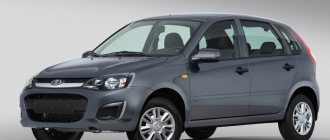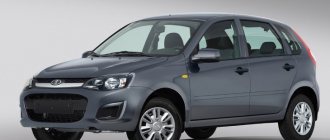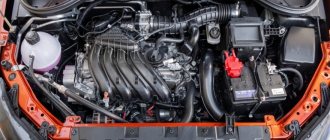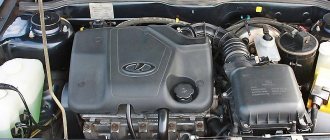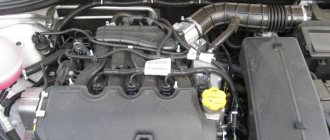Model 2111 (Lada 111) produced by AvtoVAZ is a logical continuation of the 2110 sedan. This is a five-seat front-wheel drive station wagon, created primarily for family use and transportation of small loads. Let's look at the technical characteristics of the VAZ 2111, overall dimensions, design and safety level, as well as the pros and cons of the 11th model.
Although the station wagon is no longer produced, there are still many of these cars on the used car market. Therefore, the description of the characteristics of the eleventh Lada is still relevant. The modification and characteristics of the car also depend on the year of manufacture of the Lada.
From the history
VAZ-2111 (export name Lada 111 ) is the first front-wheel drive VAZ station wagon, mass-produced since the end of 1998.
The development of the VAZ-2111 model was carried out in parallel with the base VAZ-2110.
It all started in 1985 with the search for the shape of the rear.
Layout of the 100 series in two versions. The left half was made by A. Ruzanov, the right half by S. Zaitsev (1986).
During testing, the station wagon had a hard time on the cobblestones - 500 kg of cargo is no joke. There were problems with the spars. There were a lot of problems with the trunk shelf. From the very beginning, the shelf rose when the back door was opened. There was a problem on the station wagon with the rear seat mount.
Full-scale plasticine model of a station wagon based on the 100a series. 1987
Noteworthy are the original door handles built into the glass next to the stacked windows. Didn't pass - difficult to manufacture.
Regarding the “hundred-gram windows,” experts from Belgium said that a sunroof would definitely be needed, or better yet, an air conditioner so that people would not feel discomfort.
On the 200 series a sunroof appeared. Although it was welcomed, and there was a trend and fashion in those years, the plant did not yet have experience with it, the technology had not been developed, so the hatch had to be abandoned.
We tried something else - a fixed front window (and, in fact, this can no longer be called a window, since it did not open), and behind it - an ordinary sliding glass. This pseudo-window had a spherical shape so that the difference between the surface and the glass was minimal. All this is for better aerodynamics.
Later, the original hundred-gram windows were removed. To begin with, the front door glass was divided into two halves. The front part, made of spherical glass, was rigidly fixed (for better aerodynamics), and the rear part was lowering. All the glass at the rear side door rolled down.
In 1997, a pilot production batch of VAZ-2111 was produced. The body was made at SKP, the car was driven along the conveyor belt, and the entire rear part was assembled at the OPP. It was like this for about a year. Since 1998, the station wagon has been completely assembled.
Chronology
Episode 100
200 series - appeared at the beginning of 1989. 11 VAZ-2111 units were produced. All tests required by technical specifications and regulatory documents were carried out.
300 series - manufactured in 1993 - 94. 16 VAZ-2111 units were produced.
400 series - manufactured in 1994 - 95. 2 VAZ-2111 units were produced.
500 series - manufactured in 1995. Mass pilot production batch. 2 VAZ-2111 units were produced.
Description
The engine on this car can be used in one of two options: with electronically controlled multipoint injection (each cylinder has its own injector) and an electronic ignition system. The 1.5-liter engine with 8 valves provides sufficient power (56 kW) and torque (118 Nm) with moderate fuel consumption. The engine has a displacement of 1.5 liters, with 16 valves, a twin-shaft cylinder head, providing increased power (69 kW) and torque (130 Nm), allowing the car to have improved dynamic qualities. All station wagons are equipped with a “short” main gear (3.9 instead of 3.7 in the VAZ-2110). With a total weight increased by 20 kg, the smoothness of the ride has even increased compared to the sedan.
The VAZ-2111 is available in three modifications - the basic 2111 with an injection engine, 21111 with a carburetor engine, and 21113 with a sixteen-valve engine and 14-inch wheels. Basic VAZ-2111 (VAZ-21102 sedan) with a 1.5-liter VAZ-2111 engine; VAZ-21111 with a conventional 1.5-liter VAZ-21083 engine; VAZ-21113 with a 16-valve VAZ-2112 power unit and improved brakes (analogous to the VAZ-21103 sedan).
The VAZ-2111-90 “Tarzan 2” is an all-wheel drive vehicle with a 4x4 wheel arrangement. The power unit, transmission and chassis are used from the VAZ-21213. “Tarzan 2” combines the comfort and convenience of the VAZ-2111 and the cross-country ability of Niva vehicles.
The following versions are available - “standard” (VAZ-21110-00 and VAZ-21113-00), “norm” (VAZ-21110-01 and VAZ-21113-01) and “luxury” (VAZ-21110-02 and VAZ -21113-02).
Appearance
The design of the car was borrowed from the “ten”. Essentially, this is the same VAZ-2110, only with a larger trunk and roof rails. The car has an identical shape of the front end, fenders and doors.
Many spare parts for the station wagon are suitable from “tens”. This is a big plus, which is noted by owner reviews. The VAZ-2111, depending on the configuration, was equipped with stamped or cast wheels of 14 diameter. Basic versions could also be distinguished by the plugs on the foglights. Otherwise there are no differences. Like the “ten”, branded mirrors with a bluish anti-reflective coating were used here. But motorists have different opinions about the VAZ-2111. Many people criticize these mirrors because they are uninformative and install regular ones from disassembly. In practice, some objects actually disappear in them. But this anti-reflective coating only works at night, and even then only slightly.
Modifications
- VAZ-21110 - Injector, Carburetor engine with a displacement of 1.5, 1.6 liters, with 8, 16 valves.
- VAZ-21111 - Injector, working volume 1.5l, 1.6l, 8, 16 valve.
- VAZ 2111-90 - “Tarzan 2” Under the 2111 body hides the same tarzan frame, the same Niva chassis, and with the same independent rear suspension, constructed from the Niv’s front suspension, and all-round disc brakes. True, the body is now attached to the frame not at eight points, but at ten. The engine here is no longer a “two hundred and thirteenth”, but an 1800 cc, with a more flexible “bottom”
- VAZ-21112 - Injector, working volume 1.5l, 1.6l, 8, 16 valve.
- VAZ-21113 - Injector, working volume 1.5l, 1.6l, 8, 16 valve.
- VAZ-21114 - Injector, working volume 1.5l, 1.6l, 8, 16 valve.
- VAZ-21115 - Injector, working volume 1.5l, 1.6l, 8, 16 valve.
- VAZ 21116-04 - Today it exists in the singular. This is a kind of laboratory car for testing the structural elements of all-wheel drive, developed in 1999 at the Scientific and Technical Center - a 2-liter Opel engine and chassis 21106 are “crossed” with a station wagon.
| Modification name: | hp/rpm | checkpoint | Year of release |
| VAZ 2111 78 hp | 78 / 5400 | 5 manual transmission | since 2000 |
| VAZ 2111 77 hp | 77 / 5400 | 5 manual transmission | from 2002 to 2002 |
| VAZ 2111-90 (Tarzan) 80 hp. | 80 / 5200 | 5 manual transmission | since 1999 |
| VAZ 2111-90 (Tarzan) 85 hp. | 85 / 5000 | 5 manual transmission | since 1999 |
| VAZ 21110 16V 69 hp | 69 / 5600 | 5 manual transmission | since 1998 |
| VAZ 21111 71 hp | 71 / 5600 | 5 manual transmission | from 1998 to 2004 |
| VAZ 21112 80 hp | 80 / 5200 | 5 manual transmission | since 1998 |
| VAZ 21112 91 hp | 91 / 5600 | 5 manual transmission | since 1998 |
| VAZ 21112i 91 hp | 91 / 5600 | 5 manual transmission | since 1998 |
| VAZ 21113 91 hp | 91 / 5600 | 5 manual transmission | from 2002 to 2002 |
| VAZ 21113 92 hp | 92 / 5600 | 5 manual transmission | from 2002 to 2002 |
| VAZ 21114 89 hp | 89 / 5000 | 5 manual transmission | since 2001 |
Exhaust
The VAZ-2111 is equipped with a catalytic converter, which becomes clogged at 100 thousand. Naturally, no one is replacing it. The catalyst is cut out and a blende is installed. On engines with an ECU, additional firmware is done so that fuel consumption does not increase.
The muffler begins to rust after 2-3 years of operation. It is aluminized, but this coating quickly peels off the metal. The exhaust manifold and “pants” take a very long time to take care of.
Technical characteristics of the VAZ-2111 car and its modifications
| Model | VAZ 21110 | VAZ 21111 | VAZ 21113 |
| Tradename | 1.5Li | 1,5 | 1.5GLi 16V |
| Body type | station wagon | station wagon | station wagon |
| Number of seats | 5 | 5 | 5 |
| Number of doors | 5 | 5 | 5 |
| Trunk volume, (dm3) | 750 | 750 | 750 |
| Car dimensions: | |||
| — length, (mm) | 4285 | 4285 | 4285 |
| — width without mirrors, (mm) | 1680 | 1680 | 1680 |
| — height, (mm) | 1460 | 1460 | 1460 |
| Own weight, (kg) | 1030 | 1030 | 1030 |
| Payload, (kg) | 500 | 500 | 500 |
| Base, (mm) | 2492 | 2492 | 2492 |
| Front track, (mm) | 1400 | 1400 | 1400 |
| Rear track, (mm) | 1370 | 1370 | 1370 |
| Ground clearance to engine oil pan, (mm) | 165 | 165 | 165 |
| Ground clearance to the lowest point of the exhaust system, (mm) | 140 | 140 | 140 |
| Device Features: | |||
| Engine | 2111 | 2110 | 2112 |
| Tires | 13″ | 13″ | 13″ or 14″ |
| Drive wheels | front | front | front |
| Steering | rack and pinion | rack and pinion | rack and pinion |
| Front suspension | McPherson | McPherson | McPherson |
| Rear suspension | trailing arm | trailing arm | trailing arm |
| Number of gear stages | 5 | 5 | 5 |
| Gearbox ratios: | |||
| 1st gear | 3,636 | 3,636 | 3,636 |
| 2nd gear | 1,95 | 1,95 | 1,95 |
| III gear | 1,357 | 1,357 | 1,357 |
| IV gear | 0,941 | 0,941 | 0,941 |
| V gear | 0,784 | 0,784 | 0,784 |
| Reverse | 3,5 | 3,5 | 3,5 |
| Front brakes | disk | disk | disk |
| Rear brakes | drums | drums | drums |
| Parking brake drive | cable | cable | cable |
| Clutch drive | cable | cable | cable |
| Dynamic and operational characteristics: | |||
| Maximum speed with full load, (km/h) | 160 | 160 | 180 |
| Acceleration time to 100 km/h with full load, (s) | 15 | 15 | 13 |
| Minimum turning radius, (m) | 5,2 | 5,2 | 5,2 |
| Maximum lift without acceleration | 34° | 34° | 34° |
| Braking distance loaded from 80 km/h, (m) | 38 | 38 | 38 |
| Fuel consumption at 90 km/h, (liters per 100 km) | 5,6 | 5,3 | 5,1 |
| Fuel consumption at 120 km/h, (liters per 100 km) | 7,7 | 6,7 | 6,4 |
| Fuel consumption in the urban cycle, (liters per 100 km) | 9,1 | 8,9 | 8,9 |
| Fuel tank capacity, (l) | 43 | 43 | 43 |
| Weight of towed trailer with brakes, (kg) | 800 | 800 | 800 |
| Weight of towed trailer without brakes, (kg) | 400 | 400 | 400 |
| Cx (drag coefficient) | 0,33 | 0,33 | 0,33 |
| Maximum weight of roof rack, (kg) | 50 | 50 | 50 |
| Noise level in the cabin at 100 km/h, (dB) | no more than 72 | no more than 72 | no more than 72 |
| Tire size | 175/70R13,175/65R14 | ||
About corrosion
The body is very afraid of rust. It appears within 3-4 years. Reviews from VAZ-2111 owners note that if it is not removed in time with the converter, corrosion will quickly spread throughout the entire body. To extend its life, anti-corrosion treatment should be done regularly.
Problem areas of the body are the sills and rear arches. In order to protect the latter, many install fender liners. But it is strictly forbidden to mount them on self-tapping screws - this will further accelerate the corrosion process. If you regularly treat the arches with Movil and anti-gravel, you can do without fender liners altogether.
Why did it happen so?
Perhaps the automatic requests do not belong to you, but to another user accessing the network from the same IP address as you. You need to enter the characters into the form once, after which we will remember you and be able to distinguish you from other users exiting from this IP. In this case, the page with the captcha will not bother you for quite a long time.
You may have add-ons installed in your browser that can make automatic search requests. In this case, we recommend that you disable them.
Reliability, weaknesses, maintainability
Reliability
As usual, car owners' opinions on engine reliability are divided. For example, Anatoly (Lutsk region) writes: “... The engine pleased me with its vigorous acceleration and efficiency. The unit is quite noisy, but this is typical for budget cars.” He is fully supported by Oleg (Vologda region): “... I have had a ten since 2005, I use it every day, it rides comfortably, it accelerates nicely. There are no complaints about the engine."
The second group of car enthusiasts is the complete opposite of the first. So, Sergey (Ivanovo region) says that: “... during the year of operation I had to change all the hoses of the cooling system, the clutch twice and much more.” Alexey (Moscow region) was similarly unlucky: “...almost immediately I had to change the generator relay, XX sensor, ignition module...”.
In assessing the reliability of the engine, oddly enough, both sides of car enthusiasts are right. And that's why. If you treat the engine as the manufacturer recommends, then its reliability is beyond doubt.
There are examples when the engine mileage without major repairs exceeded 367 thousand km. At the same time, you can meet many drivers who, among all the maintenance, only fill up gasoline and oil in a timely manner. Naturally, their engines are “extremely unreliable.”
Weak spots
The weak points include the “triple” of the motor. This is an extremely unpleasant symptom for the car owner. In most cases, the cause of this phenomenon is the burnout of one or even several valves.
But it happens that this trouble is caused by a failure in the ignition module. The true cause of the engine tripping can be identified at a service station during engine diagnostics.
Another serious malfunction is the occurrence of unauthorized knocks. There are several reasons for the occurrence of extraneous noise. Most often, unadjusted valves are to blame.
At the same time, the “authors” of knocking can be the pistons, or the main or connecting rod bearings (liners) of the crankshaft. In this case, the engine requires serious repairs. Diagnostics at a car service center will help identify this problem.
And the last of the serious problems is overheating of the internal combustion engine. Occurs as a result of failure of components and parts of the cooling system. The thermostat and fan are unstable. Failure of these components guarantees overheating of the motor. Therefore, it is extremely important for the driver to monitor not only the road, but also the instruments while driving.
The remaining engine weaknesses are less critical. For example, the appearance of floating speed when the engine is running. As a rule, this phenomenon occurs when any sensor fails - mass air flow sensor, IAC or TPS. It is enough to detect and replace the faulty part.
Oil and coolant leaks. Mostly they are minor, but they cause a lot of trouble. Leaks of technical fluids can be eliminated by simply tightening the seal fasteners at the point where they appear, or by replacing a faulty oil seal.
